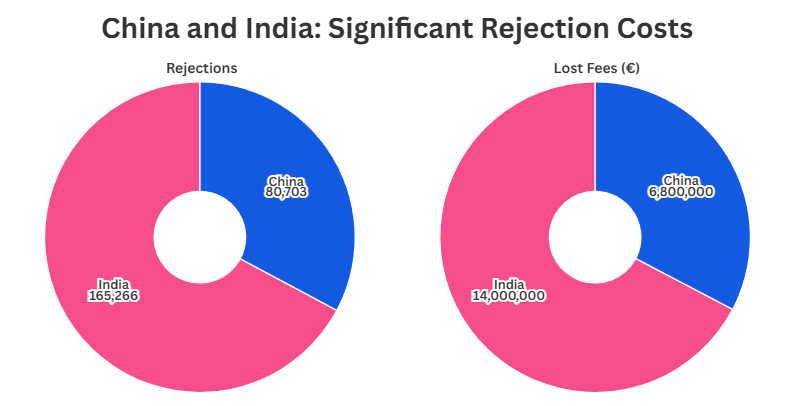Schengen Visa Rejections in 2024: China and India Among Top Nations Facing High Financial Losses
- Wing Ho

- May 27
- 3 min read
The Schengen visa application process in 2024 saw a dramatic surge in both applications and rejections, costing applicants a staggering €145 million in lost fees. Among the most affected were travellers from China and India, who faced not only high application volumes but also significant rejection rates, leading to millions in financial losses.
In this blog, we dive into the latest Schengen visa data, highlighting the key trends, the financial impact on applicants—especially from China and India—and what this means for future travellers.

2024 Schengen Visa Trends: More Applications, More Rejections
In 2024, 11.7 million Schengen visa applications were filed—a 13.4% increase from 2023. However, rejections also rose, with 1.7 million applications denied (a 4.4% increase from the previous year).

With the EU increasing visa fees from €80 to €90 in June 2024, the financial burden of rejections became even heavier. Key insights:
Total visa fees collected by the EU in 2024: €995.9 million (up 20.5% from 2023).
Total lost by rejected applicants: €145 million (an 11% increase from 2023).
Average cost per application: €85 (accounting for the mid-year fee increase).
While the overall rejection rate slightly decreased (from 15.8% in 2023 to 14.5% in 2024), the financial losses grew due to higher application volumes and increased fees.
China and India: High Application Numbers, Significant Rejection Costs
China and India were among the top three countries with the highest number of Schengen visa applications—and consequently, some of the highest financial losses due to rejections.

Why Are Rejections High for These Countries?
Stricter Scrutiny – Due to high application volumes, consulates may apply more rigorous checks.
Documentation Issues – Incomplete or inconsistent paperwork is a leading cause of rejections.
Overstaying Risks – Some applicants may face scepticism regarding their intent to return.
For Indian applicants, the rejection rate was particularly notable, with €14 million lost —the third-highest financial loss globally after Algeria and Türkiye.
Other Most-Affected Countries
While China and India faced substantial losses, African nations had the highest rejection rates, leading to severe financial impacts:
Algeria – €15.7 million lost (185,101 rejections)
Nigeria – €4.2 million lost
Senegal – €2.7 million lost
Comoros – Highest rejection rate (61.5%), losing €149,090
Which Schengen Countries Rejected the Most Visas?
France, Spain, and Germany processed—and rejected—the highest number of applications, collectively earning €79 million from rejected visas alone.
Top 5 Schengen Countries by Visa Revenue
France – 3M+ applications, €261.1M earned
Spain – 1.6M applications, €138.9M earned
Germany – 1.5M applications, €128.5M earned
Italy – 1.2M applications, €104.8M earned
Netherlands – €633.5M combined revenue (63.6% of total Schengen visa income)
How Can Future Applicants Improve Approval Chances?
Given the rising costs and rejection risks, applicants—especially from high-volume countries like China and India—should:
✅Submit complete documentation
Ensure all required paperwork is accurate and consistent.
✅ Provide strong proof of ties to home country
Employment letters, property ownership, or faly dependents can help.
✅ Apply well in advance
Avoid last-minute errors by submitting early.
✅Consider professional consultation
Visa experts can help navigate complex requirements.
Final Thoughts
The Schengen visa process remains a costly and uncertain journey, with China and India among the nations facing the highest financial losses due to rejections. While African countries still experience the worst rejection rates, the sheer volume of applications from China and India means millions are lost annually in non-refundable fees.





Comments